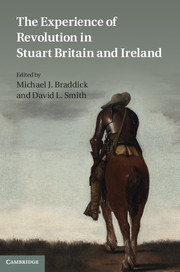Book contents
- Frontmatter
- Contents
- Notes on contributors
- Preface
- List of abbreviations
- JSM
- Introduction: John Morrill and the experience of revolution
- 1 The Scottish–English–Romish Book: the character of the Scottish Prayer Book of 1637
- 2 Popery in perfection? The experience of Catholicism: Henrietta Maria between private practice and public discourse
- 3 Sir Benjamin Rudyerd and England's ‘wars of religion’
- 4 Rhetoric and reality: images of Parliament as Great Council
- 5 Cathedrals and the British Revolution
- 6 History, liberty, reformation and the cause: Parliamentarian military and ideological escalation in 1643
- 7 Sacrilege and compromise: court divines and the king's conscience, 1642–1649
- 8 Law, liberty, and the English Civil War: John Lilburne's prison experience, the Levellers and freedom
- 9 On shaky ground: Quakers, Puritans, possession and high spirits
- 10 James Harrington's prescription for healing and settling
- 11 ‘The Great Trappaner of England’: Thomas Violet, Jews and crypto-Jews during the English Revolution and at the Restoration
- 12 The Cromwellian legacy of William Penn
- 13 Irish bishops, their biographers and the experience of revolution, 1656–1686
- 14 Religion and civil society: the place of the English Revolution in the development of political thought
- Bibliography of the major writings of John Morrill, 1967–2009
- Index
4 - Rhetoric and reality: images of Parliament as Great Council
Published online by Cambridge University Press: 05 August 2011
- Frontmatter
- Contents
- Notes on contributors
- Preface
- List of abbreviations
- JSM
- Introduction: John Morrill and the experience of revolution
- 1 The Scottish–English–Romish Book: the character of the Scottish Prayer Book of 1637
- 2 Popery in perfection? The experience of Catholicism: Henrietta Maria between private practice and public discourse
- 3 Sir Benjamin Rudyerd and England's ‘wars of religion’
- 4 Rhetoric and reality: images of Parliament as Great Council
- 5 Cathedrals and the British Revolution
- 6 History, liberty, reformation and the cause: Parliamentarian military and ideological escalation in 1643
- 7 Sacrilege and compromise: court divines and the king's conscience, 1642–1649
- 8 Law, liberty, and the English Civil War: John Lilburne's prison experience, the Levellers and freedom
- 9 On shaky ground: Quakers, Puritans, possession and high spirits
- 10 James Harrington's prescription for healing and settling
- 11 ‘The Great Trappaner of England’: Thomas Violet, Jews and crypto-Jews during the English Revolution and at the Restoration
- 12 The Cromwellian legacy of William Penn
- 13 Irish bishops, their biographers and the experience of revolution, 1656–1686
- 14 Religion and civil society: the place of the English Revolution in the development of political thought
- Bibliography of the major writings of John Morrill, 1967–2009
- Index
Summary
The Long Parliament which convened in November 1640 has always been seen as being of central importance to the broader narrative of English history. Its notoriety derives, in the first instance, from the critical role it played in the onset – and subsequent conduct – of the English Civil War and Revolution. But it is also seen to be critically important to the history of the institution itself and to Parliament's evolving sense of its own role and responsibilities. The collapse of the king's government in 1640, the resulting (and immediate) need to fill the administrative vacuum and the eventual demands of governing in wartime all worked inevitably to bring about a fundamental transformation during the ensuing decade. Traditionally (and certainly through the parliaments of the 1620s) Parliament had been called primarily to do ‘the king's business’ and it did so in three clearly defined ways: by offering advice and counsel to the king's government on contemporary problems; by joining the king in passing legislation to correct those problems and any others which they or the king's ministers might have identified; and (rather less conspicuously) by enforcing the king's laws through the judicial process of impeachment or through appellate review in the House of Lords. Parliament's functions were advisory, legislative and judicial. They were not, and until 1640 were not presumed to be, either administrative or executive in nature.
- Type
- Chapter
- Information
- Publisher: Cambridge University PressPrint publication year: 2011



